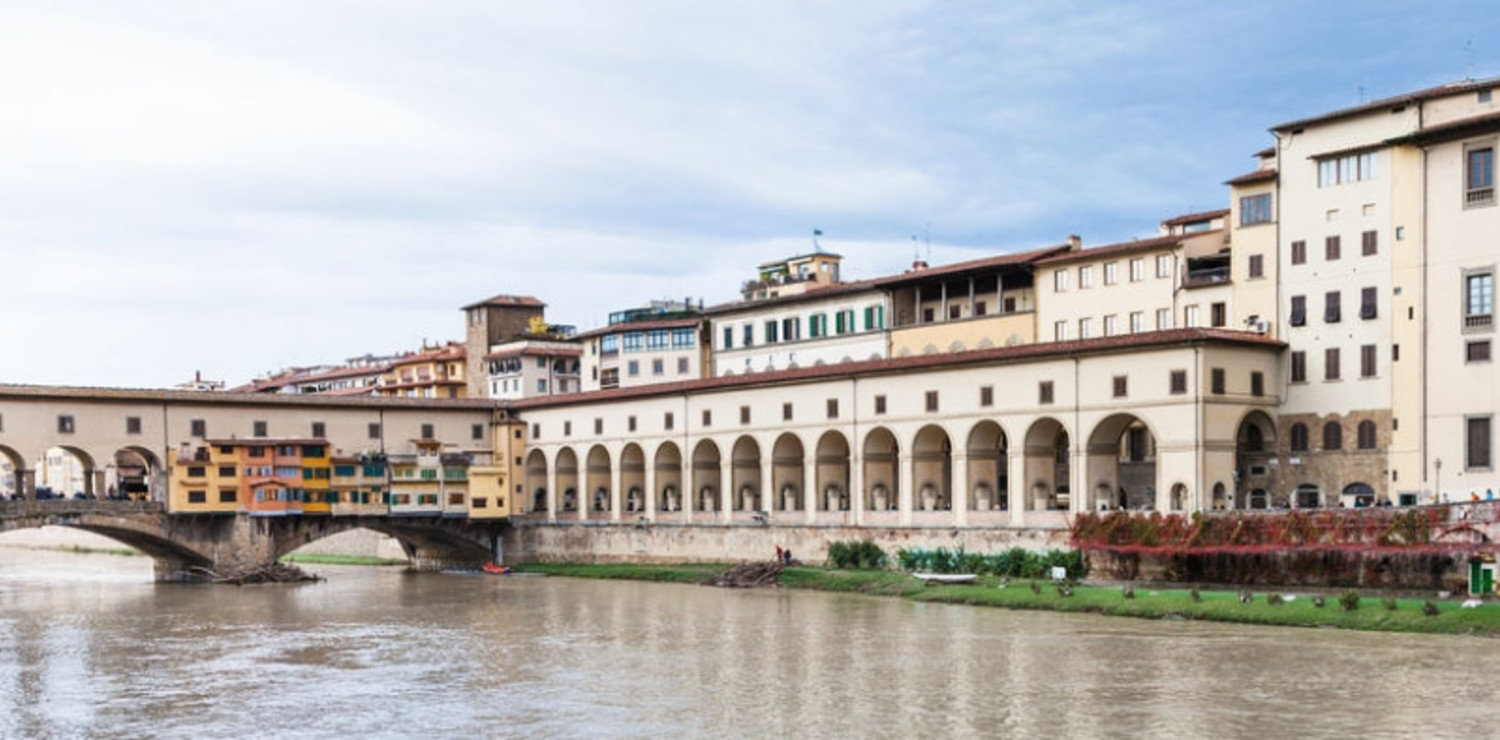The Vasari Corridor told by Antonio Natali
The Director of the Uffizi is our exceptional guide, for a journey of art and charm
From the gallery, you enter through a large door on the left: we’re in 16th century architectural marvel known as the Vasari Corridor, a stories-high pathway that slices inconspicuously through the heart of Florence. You walk through the door and meet a majestic staircase marked by iron handrails and a wound inflicted by the bombing on via dei Georgofili; it scarred the Caraveggesque work that decorates the beginning of the passageway. The force of the explosion shook the walls as if they were boats sails, blasting parts of the work apart into confetti. Certain details can still be traced: the intense chiaro scuro, the plumpness of the cherubs; the tragedy that took place on the night of March 26, 1993, lends the figures added gravitas. Beside the work you will read: “a city struck at the heart, but not killed,” the verses of Mario Luzi. Anotonio Natali, director of the Uffizi and guide par excellence during our special visit, wanted those words there beside the work. We pass quickly through the first tract of the passage: a few more scars, small tears that peel open irreparable 17th century tapestries and cracks in busts that bare other, more recent injuries. “We traced the painting at the entrance in a flyer from 1967 called Saved from the water, printed right after the flood.” Paintings from the 17th to 18th centuries trace the walls: while discuss Vasari, the colors and figures come together as if a single fresco. Each of these works would require pages to describe, such is the harmony of their lines and colours. Some are copies of works from the era, explains the director, when copies were done by great masters and were often as acclaimed as the originals. “Vasari was a manager,” he starts, asserting after the last word that he dislikes the use of foreign words in the Italian language. But there exists no modern Italian word that better defines the architect who in five months designed and built the Corridor that begins in the Uffizi, takes form over via della Ninna, becomes a roof over the shops of the Ponte Vecchio and circumnavigates the Torre dei Mannelli , peeks into the Chiesa di Santa Felicita, steps over the Guicciardini homes, arrives in the Boboli Gardens and spills into Palazzo Pitti. New plans to restructure the Corridor mention removing the artwork from the walls, transforming it into a mere covered route between two monuments. Natali, ca va sans dire, does not agree: it would rip the spirit out of the Florentine passage and distort its function. It is too narrow, too cramped to accommodate doubled up lines of visitors moving in both directions between Palazzo Pitti and the Uffizi. Natali, rather, opts to remove the iconographic final portion of the Corridor and highlight the self-portraits, the true treasure of the passage. The portraits range from the 16th to 20th century, making for 450 faces and a journey through art history. These are the hands and eyes that made masterpieces, they attest to their lives and works, they demonstrate the evolution of how we reveal ourselves to the world, they tell us about their epochs and their individual ways of life. The complete collection boasts 1750 works and a series of contemporary names with entire exhibits dedicated to them: Gian Lorenzo Bernini, Annibale Carracci, Francesco Primaticcio, Lavinia Fontana, Federico Barocci; the great masters of the 20th century like Ligabue, De Chirico, Manzù, Balla, Paladino, Fontana, Pistoletto, Carrà, just to name a few. Not to mention foreign artists both from the past, such as Rembrandt, Reynolds, Ingres and Ensor, and from the present, like Chagall, Rauschenberg, Joseph Beuys. The collection was officially ammassed by Cardinal Leopoldo during the early 1680s, starting with a few self portraits from his family’s personal collection. The collection grew over time, bolstered first by the Medici then by the Lorena. In 1981, in honour of the 400th anniversary of the Uffizi, then-director Berti – a great man and student of the arts – added a modest number of works, asking famous artists to donate a self-portrait to the collection. In addition, many donations were made that were taken into careful consideration and not used for two years, until 1983,” recounts the current director. Many of the donations were of breathtaking beauty – Chagall’s blue features enrapture, not to mention Morandi’s contribution, in which he depicts himself waiflike and frozen as if another of his still life’s. Then there is the irony of others, like the portrait of Nicola Van Houbraken that tears through the canvas and seems to jump from its frame, or Autograffe by Balla – they acquire immense power together. To look into those eyes, each pair seeming eager to tell their story and their time, is to experience emotions impossible to describe. Suffice it to say that this is a journey worth experiencing. The most recent addition to the collection is a contribution by three contemporary Japanese artists that, despite all odds, did not want to miss their chance to write on the walls of the Corridor. “The self portrait is the only way for living artists to contribute to the Uffizi collection. We invite the Italian artists to donate works, and trust Italian cultural institutes worldwide to select the foreign works. Using only the quality criteria of our personal acquisitions committee would be limiting. An artist has value when he represents his country,” explains Natali. If you ask him about the collection’s missed chances, he will murmur:
“Soffici, Modigliani”. Bill Viola, who’s already connected with Florence? Francesco Clemente, perhaps? He won’t comment on those.









